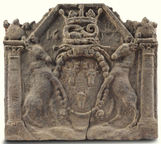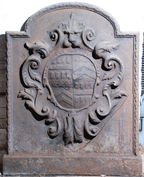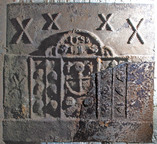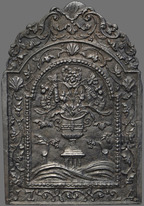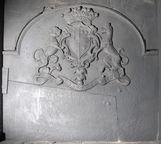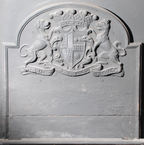-
245
Description: Arched rectangular shaped with narrow shoulders; fillet edging; date in individual numerals across arch.
Notes: A larger version is different in the spacing of the numerals and the proportions of the plate. For another casting of this fireback see J. Every Collection catalogue #20 (Sussex Archaeological Society library, Barbican House, Lewes, Sussex).
Copies of this fireback are known.
Inscription: 1658
- Decoration tags:
- rectangular with round arch (shape)
- rope (edging)
- carved stamps
- individual numbers
- text
Manufactured: in 1658 possibly in the Weald area of England.
Current location: Lytes Cary Manor, Charleton Mackrell, Somerset, England.
Museum number: 254606 (part of the National Trust museum group)
- Attached to series:
- 1658 arched series
- Date only firebacks
-
1084
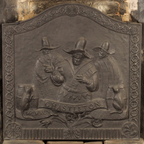 ? x ? mmImage subject to copyright
? x ? mmImage subject to copyrightDescription: Ogee-arched rectangular shaped central panel with fillet edging; pictorial scene with three figures dressed in clothing of the early 17th century, with wide-brimmed hats, the central figure to the fore and wearing doublet and belt, the two others in coats; across the bottom a trpartite scroll bearing the inscription CHASTLETON on the upper part, and the date MCMXCV and C of A (Charteris of Amisfield) & [illegible] R split between the lower parts, with three tulips beneath; resting on each outer part of the scroll, a barrel with a cat; an ogee-arched rectangular border with fillet edging with floral guilloche decoration and daisy flowers at the top and in the top corners; in the bottom left corner the circular badge of the National Heritage Memorial Fund, and in the bottom right corner the circular badge of the National Trust.
Notes: This fireback was cast for Martin, Lord Charteris of Amisfield (1913-99), Trustee of the National Heritage Memorial Fund, from a pattern he designed and made, to commemorate the 390th anniversary of the Gunpowder Plot; cast with figures associated with Robert Catesby, owner of a previous house on the site and one of the chief conspirators, and the cats belonging to the then owner, Mrs Barbara Clutton-Brock.
Inscription: CHASTLETON / MCMXCV / C of A & [?]R
- Decoration tags:
- rectangular with round arch (shape)
- fillet (edging)
- whole carved pattern
- pictorial
- text
- animals
- humans
- plants
- objects
Manufactured: in 1995 in England.
Current location: Chastleton House, Chastleton, Oxfordshire, England.
Museum number: 1430298 (part of the National Trust museum group)
- Attached to series:
- Martin Charteris firebacks
- Commemorative firebacks
-
874
Description: Arched rectangular central panel with ovolo linking curves and eyelet astragal edging; pictorial scene of Delilah, seated above a pavement, supervising the cutting of Samson's hair by a barber, a putto to the left and a small figure lower right; drapery above; arched rectangular border with ovolo linking curves and fillet edging; symmetrical pattern of plant tendrils with leaves and seed pods; at bottom, monogram 'EB' in a cartouche between symmetrical leaves and ears of wheat; on top, two mirrored sea serpents.
Notes: One of a small series of firebacks identified by the EB monogram; the pictorial scene is of Delilah and the sleeping Samson with a Philistine cutting his hair; the scene may be based on an engraving by the Dutch artist Philip Galle (1537-1612) after a painting by Maerten van Heemskerck.
Copies of this fireback are known.
Inscription: EB
Manufactured: in the late-17th to early-18th century in England.
Current location: Chastleton House, Chastleton, Oxfordshire, England.
Museum number: 1430205 (part of the National Trust museum group)
- Attached to series:
- EB series
- Old Testament & Apocrypha firebacks
- British 'Dutch' style firebacks
-
246
Description: Quasi-arched rectangular shape; on a ground, an armorial achievement comprising a central cartouche on which is an oval shield bearing the arms of the Cavendish family, with graduated bead edging; supporters, two stags rampant; above the cartouche, on a wreath a coiled snake crest surmounted by an earl’s coronet; the date split either side of the crest; to each side, a column with foliate capital supporting a three-sided arch with ovolo-moulded edging, on each shoulder of which is a flaming orb.
Notes: The arms are those of William Cavendish, 3rd Earl of Devonshire (1617-84). Sotheby's auction, The Chatsworth Attic Sale, 7 Oct 2010, lot 3 (£18,750).
Inscription: 1657
Arms: William Cavendish, 3rd Earl of Devonshire
- Decoration tags:
- rectangular with three-facetted arch (shape)
- complex individual (edging)
- whole carved pattern
- individual numbers
- armorial
- text
Manufactured: in 1657 in England.
Current location: not known.
- Attached to series:
- Personal armorial firebacks
- Cavendish arms series
-
247
Description: A modified recasting of a variant of the ‘Armada’ fireback, with initials changed to IK, a single anchor panel, and the addition of a plain base and borders, the latter each with a twisted rope saltire, upper middle.
Notes: It is likely that an original four-panel fireback has been used to recast a copy with additional side and base panels; the saltires may have apotropaic significance. A second fireback at the house cast in the 19th century is identical but for being 1% smaller all round, and has a full-width extension on top bearing four symmetrical rope saltires, the outer two larger than the inner two. The first example was used to make the second.
Inscription: 1588 / IK
- Decoration tags:
- rectangular with round arch (shape)
- simulated rope (edging)
- simple stamps
- carved pattern panels
- composite
- extension panels
- apotropaic
- text
- plants
- objects
Manufactured: in the 17th century in the Weald area of England.
Current location: Chawton House, Chawton, Hampshire, England.
- Attached to series:
- Armada series
-
34
Description: Arched rectangular shape; astragal and fillet edging (top and sides) with overlapping leaf pattern; floral cartouche with lion’s face at top, enclosing a shield bearing the arms of May (Gules, a fess between eight billets Or) quartering Broadnax (Or, two chevrons gules, on a chief of the last three cinquefoils Argent); at base a plain cuboid plinth.
Notes: Thomas Broadnax (1701-81), son of William Broadnax of Godmersham, Kent, and Anne May, heiress of Christopher May, inherited the estate of his cousin, Sir Thomas May, adopting his surname in 1727. He later changed his name to Knight on inheriting the estate of that family at Chawton in 1738.
Arms: May quartering Broadnax
- Decoration tags:
- rectangular with round arch (shape)
- astragal & fillet (edging)
- carved pattern panels
- armorial
Manufactured: in the early-18th century possibly in the Weald area of England.
Current location: Chawton House, Chawton, Hampshire, England.
- Attached to series:
- Personal armorial firebacks
-
1148
Description: A composite recasting placing, on a plain background with symmetrical rope saltires, a recast variant of the ‘Armada’ fireback, with changed initials, a single anchor panel, and the addition of plain base and borders, the latter each with a twisted rope saltire, upper middle.
Notes: It is likely that an original four-panel fireback was used to cast an early copy with additional side and base panels. In the 19th century this second fireback was used to cast this third fireback with an additional full-width extension on top bearing four symmetrical rope saltires, the outer two larger than the inner two. The image of this fireback has been reconstructed by computer, combining photographs of the two fragments into which it had been broken.
Inscription: 1588 / IK
- Decoration tags:
- rectangular (shape)
- none (edging)
- simple stamps
- carved pattern panels
- composite
- apotropaic
- text
- plants
- objects
Manufactured: in the early- to mid-19th century in England.
Current location: Chawton House, Chawton, Hampshire, England.
- Attached to series:
- Armada series
- Composite firebacks
-
1032
Description: Arched rectangular shaped central panel with solid and hollow bead on fillet edging, grouped alternately in threes and twos respectively, on a wide fillet; on a Tuscan pedestal rising from waves, a narrow waisted, gadrooned flower vase with two scrolled handles and a horizontal banded decoration from which issue tendrils bearing flowers, berries and seed pods; arched rectangular shaped border with fillet edging, wide at the sides, symmetrical floral fronds descending from a scallop shell, top centre, with a scallop shell inside each shoulder; at base, date split between two looped 'W' figures; on top, symmetrical scrolled plant tendrils descending from a central scallop shell.
Notes: The third largest of six flower vase firebacks designed and made in the same year, larger ones of which include a religious inscription in Welsh. All incorporate the looped 'W' motif which may be intended to identify the pattern maker. Cheffins auction, Cambridge, 13 Jun 2018, lot 738 (£240).
Copies of this fireback are known.
Inscription: 17 24
Manufactured: in 1724 in England.
Current location: not known.
- Attached to series:
- 1724 series
- British 'Dutch' style firebacks
-
248
Description: Arched rectangular shape; astragal and fillet edging; shield, motto, earl’s coronet and supporters (a talbot erm. and a wolf or, ducally crowned gu.) of Stanhope impaling Pitt: quarterly (1st & 4th) erm. (2nd & 3rd) gu. (Stanhope); sa., a fess chequy az. and ar. between three bezants (Pitt); motto: A DEO ET REGE.
Notes: James Stanhope was created 1st Earl in 1718; he had married Lucy Pitt in 1714. The Stanhope seat was Chevening, near Sevenoaks.
Inscription: A DEO ET REGE
Arms: Stanhope impaling Pitt; James, Ist Earl Stanhope
- Decoration tags:
- rectangular with round arch (shape)
- astragal & fillet (edging)
- carved pattern panels
- armorial
- text
Manufactured: in the early-18th century in England.
Current location: Chevening Park, Chevening, Kent, England.
- Attached to series:
- Personal armorial firebacks
- Stanhope series
-
249
Description: Arched rectangular shape; astragal and fillet edging; shield, motto, earl’s coronet and supporters (a talbot erm. and a wolf or, ducally crowned gu.) of Stanhope impaling Pitt: quarterly (1st & 4th) erm. (2nd & 3rd) gu. (Stanhope); sa., a fess chequy az. and ar. between three bezants (Pitt); motto: A DEO ET REGE.
Notes: James Stanhope was created 1st Earl in 1718; he had married Lucy Pitt in 1714. The Stanhope seat was Chevening, near Sevenoaks.
Inscription: A DEO ET REGE
Arms: Stanhope impaling Pitt; James, 1st Earl Stanhope
- Decoration tags:
- rectangular with round arch (shape)
- astragal & fillet (edging)
- carved pattern panels
- armorial
Manufactured: in the early-18th century in England.
Current location: Chevening Park, Chevening, Kent, England.
- Attached to series:
- Personal armorial firebacks
- Stanhope series


